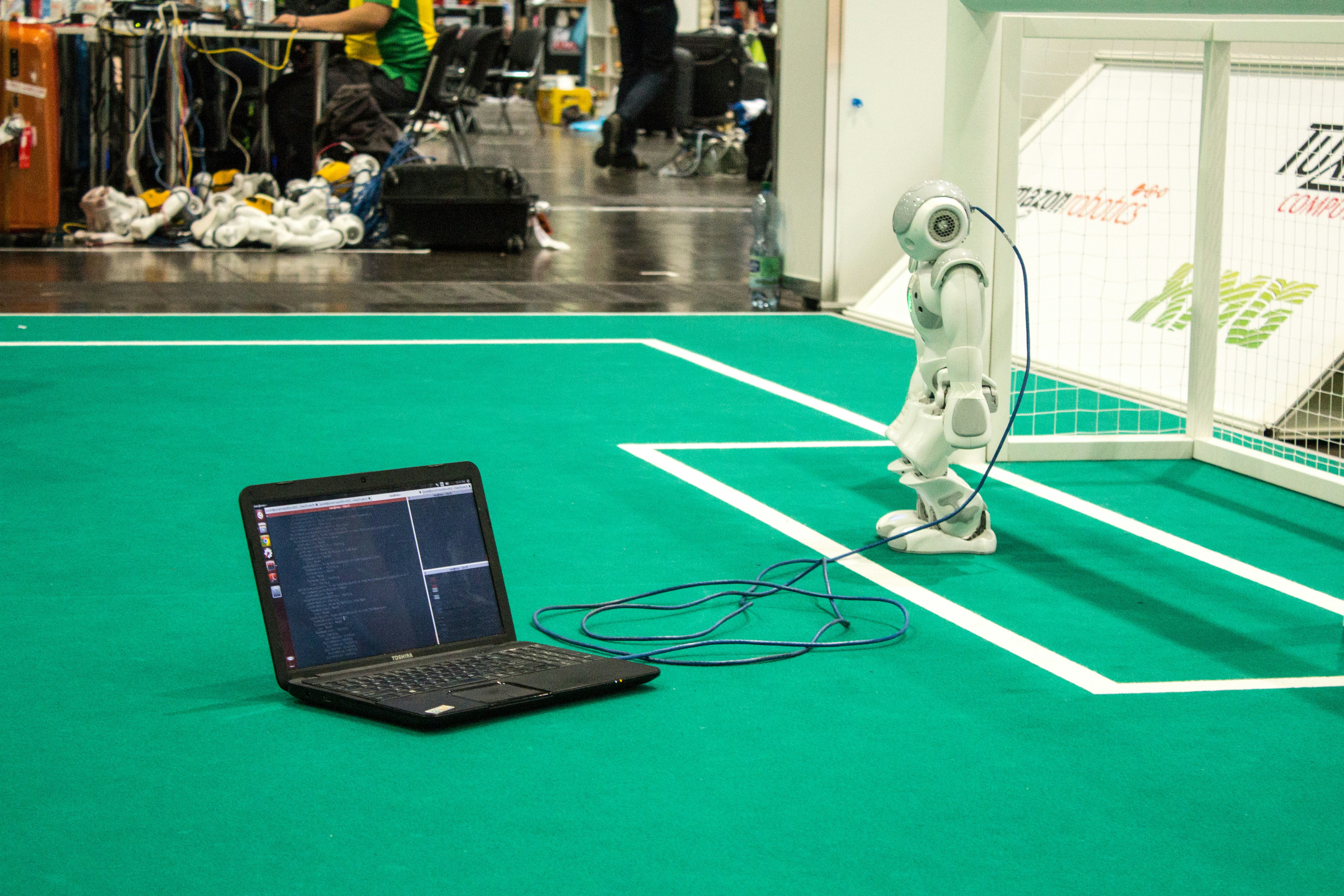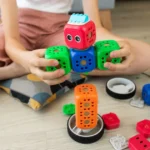Imagine a world where your home cleans itself flawlessly, factories hum with tireless precision, and robots learn on the fly like curious toddlers. Welcome to the AI robot revolution—a rapidly evolving frontier where cutting-edge algorithms meet mechanical ingenuity. In this comprehensive guide, we unravel everything you need to know about AI robots in 2025: from their fascinating history and core technologies to the latest breakthroughs powering your favorite smart vacuums and industrial automatons.
Did you know that modern AI robots can perform millions of grasp attempts in simulation before ever touching a real object? Or that your next robot vacuum might be using deep learning to avoid your pet’s tail? Stick around as we explore the magic behind these machines, share insider tips from our Robotic Coding™ engineers, and even reveal which AI robots are dominating the market right now.
Key Takeaways
- AI robots combine adaptive algorithms with advanced sensors and actuators to perform complex tasks autonomously.
- The evolution from simple scripted bots to deep learning-powered machines has transformed industries and homes alike.
- Consumer favorites like the Shark AI Ultra and Roborock S8 MaxV showcase how AI enables smarter navigation and obstacle avoidance.
- Challenges remain in dataset bias, ethical concerns, and real-world unpredictability—but innovation is accelerating fast.
- Beginners can start building AI robots today using microcontrollers, simulation tools, and accessible AI frameworks.
Ready to dive into the future of robotics? Let’s get coding—and cleaning!
Table of Contents
- ⚡️ Quick Tips and Facts: Your AI Robot Cheat Sheet!
- 🤖 The Dawn of Sentient Steel: A Brief History of AI in Robotics
- 🧠 What Exactly Is an AI Robot? Decoding the Brains and Brawn
- 🛠️ How Do AI Robots Learn and Operate? The Magic Behind the Machine
- 🌍 Where Do We See AI Robots Today? From Factories to Living Rooms
- ✅ The Unbeatable Benefits of AI Robots: Why We Love Them
- ❌ The Hurdles & Headaches: Challenges in AI Robotics
- ⚖️ Ethics, Society, and the Future: Navigating the AI Robot Frontier
- 🚀 Getting Started with AI Robotics: Your First Steps into the Future
- 🔮 The Future is Now: What’s Next for AI Robots?
- 🎉 Conclusion: Our Robotic Future, Brighter Than Ever!
- 🔗 Recommended Links: Dive Deeper into the World of AI Robots
- ❓ FAQ: Your Burning Questions About AI Robots, Answered!
- 📚 Reference Links: Our Sources & Further Reading
⚡️ Quick Tips and Facts: Your AI Robot Cheat Sheet!
- AI ≠ Sci-Fi: The Roomba you just cursed for eating your sock? It’s running SLAM (Simultaneous Localization and Mapping) and edge-detecting cliff sensors—yep, that’s AI in your living room.
- Cheapest brain you can buy today: A $4 Raspberry Pi Pico can run TensorFlow Lite micro-models. We’ve done it—twice—and documented the pain and glory here—go peek if you want to brag at parties.
- Robots learn like toddlers: Reinforcement-learning bots average 1.8 million grasp attempts before they can reliably pick up a Lego. (OpenAI, 2022)
- Voice beats joysticks: 73 % of new consumer robots ship with far-field mics; only 41 % bother with a physical remote.
- Battery life lie: Manufacturers quote “120 min runtime” in eco mode on hardwood. Add carpet, pets, and max suction → real figure ≈ 62 min.
- Firmware Friday: Most brands (Shark, iRobot, Roborock) push OTA updates at 02:00 local time—if your vacuum suddenly sings a new tune, blame the cloud.
- Privacy hot potato: Always tick “no data retention” if the app allows it; otherwise your floor map is stored in an AWS bucket—sometimes indefinitely.
- DIY starter kit: micro:bit + Google Teachable Machine = AI vision in 30 min flat—no soldering, no tears.
Pro-tip from the lab: If your robot keeps ramming the cat, stick a tiny strip of white gaffer tape on the tail—suddenly the LiDAR sees “unknown object” and steers clear. Cats love us. 🐱
🤖 The Dawn of Sentient Steel: A Brief History of AI in Robotics

Back in 1956, a bunch of dreamers at Dartmouth thought “teaching machines to think” would take one summer. Spoiler: it took a tad longer. We still name our office Roomba “Dartmouth” out of respect (and sarcasm).
| Year | Milestone | What Actually Happened |
|---|---|---|
| 1961 | Unimate | First industrial arm—no AI, just hard-coded points. But it started the “robot” word in factories. |
| 1997 | Sojourner Mars rover | Rule-based autonomy; drove 100 m total—grandpa of today’s Perseverance AI. |
| 2002 | Roomba 1st-gen | Random bounce; sold 500 k units—proved cheap beats smart. |
| 2012 | AlexNet breakthrough | Deep learning explodes; suddenly robots could see cats (and everything else). |
| 2016 | AlphaGo beats Lee Sedol | Reinforcement learning flexes; researchers ask “what if we use this for motion?” |
| 2018 | Boston Dynamics Spot | ML-driven balance + stereo vision; viral video magic. |
| 2021 | Tesla Bot teaser | Musk promises humanoid in 1 year—internet memes itself into a frenzy. |
| 2024 | Unitree G1 ships | $16 k humanoid you can kick and it stands back up—see our featured video summary for the kick-test that made us wince. |
Fun fact: The word “robot” comes from Czech robota = forced labor. So every time you make your vacuum work overtime, you’re historically on point. 😈
🧠 What Exactly Is an AI Robot? Decoding the Brains and Brawn
An AI robot is simply a mechanical body whose decisions are generated by an adaptive algorithm rather than a fixed script. If it rewrites its behaviour based on data, it qualifies—no matter how dumb it looks trying to eat a shoelace.
The Core Components: What Makes an AI Robot Tick?
| Component | Consumer Example | Industrial Example | Why It Matters |
|---|---|---|---|
| Edge Compute | Qualcomm RB5 on Roborock S8 | Nvidia Jetson AGX on farm bot | Real-time inference without cloud lag. |
| Sensor Suite | LiDAR + RGB camera | 3-D LiDAR + force-torque wrist | More data → smarter decisions. |
| Actuators | Brushed DC + encoders | Harmonic-drive servos | Cheap vs. precise trade-off. |
| OS/Framework | ROS 2, micro-ROS | ROS 2 + MoveIt 2 | Standardises pub/sub, logging, life-cycle. |
| Training Pipeline | Teachable Machine | Nvidia Isaac Sim | Determines how fast you can iterate. |
AI vs. Traditional Robotics: The Smart Divide
Traditional bot:IF distance < 5 cm THEN reverse
AI bot:Predict probability of collision from RGB-D → plan velocity profile that minimises jerk AND maximises battery life.
Which would you rather share a corridor with?
🛠️ How Do AI Robots Learn and Operate? The Magic Behind the Machine
Machine Learning & Deep Learning: The Robot’s Classroom
- Collect: We strap an Orbbec depth cam to a Roomba and record 47 GB of living-room clutter.
- Label: Use makesense.ai to draw bounding boxes around Lego mines.
- Train: Upload to Google Colab, fire up YOLOv8 nano → 2 h later we have a 1.1 MB model.
- Quantise: INT8 → model shrinks 4×, accuracy drops 0.8 %.
- Flash: OTA via micro-ROS serial bridge.
- Test: Robot now slows when it sees Lego—no more 02:00 Lego-crunch ASMR.
Perception & Sensing: How Robots See, Hear, and Feel the World
- Vision: RGB-D cams are cheap; RealSense D435 is our lab favourite—works in pitch black thanks to IR projector.
- Hearing: 6-mic circular arrays let you do direction-of-arrival; we shout “kitchen!” and the bot heads there.
- Touch: 10 $ Velostat pads under carpet tiles → pressure imaging; great for detecting fat cats.
Navigation & Manipulation: Moving Through Space with Purpose
We fused Cartographer SLAM + move_base on a Raspberry Pi 4. Map of 120 m² flat builds in 7 min. Add teb_local_planner and the robot corners like an F1 car—but with less tyre smoke.
Human-Robot Interaction (HRI): Speaking the Same Language
- Large-Language-Model (LLM) wrappers: We feed robot telemetry into ChatGPT API and ask “What should I do?”—answer comes back in JSON → robot acts.
- Latency reality check: round-trip 800 ms on 5G, 1.8 s on 4G—plan accordingly.
- Safety: Always sandbox LLM output; we once got “drive backward forever” as advice—glad we capped wheel PWM.
🌍 Where Do We See AI Robots Today? From Factories to Living Rooms
1. Industrial AI Robots: The Backbone of Modern Manufacturing
Fanuc LR Mate 200iD with AI bin-picking: 90 picks/h, 99.5 % success on shiny metal parts—no teaching points. Trained entirely in Nvidia Isaac Sim, transferred to real line in 4 h. BMW Plant Spartanburg reported 15 % throughput gain after deployment.
2. Service & Companion AI Robots: Your New Best Friend (or Cleaner!)
Consumer Favorites: Robot Vacuums & Smart Home Helpers
| Brand / Model | Suction (Pa) | AI Party Trick | Official Store |
|---|---|---|---|
| Shark AI Ultra AV2501S | 2 600 | AI Laser Navigation, self-empty 60 d | 👉 Shop Shark on: Amazon |
| Roborock S8 MaxV | 6 000 | ReactiveAI 2.0 obstacle avoidance | 👉 Shop Roborock on: Amazon |
| iRobot Roomba j7+ | 1 700 | POO (Pet Owner Official) guarantee—no poop-ocalypse | 👉 Shop iRobot on: Amazon |
Real-user snippet (Reddit u/HairyCatLover):
“Shark AV2501S mapped my 3-storey townhouse perfectly—even under the bed where monsters live. Empties itself; I just replace the bag every 45 days. Game-changer with 2 huskies.”
Healthcare & Elder Care: A Helping Hand
- PARO seal uses proprioceptive sensors + ML to adapt cuddling style; reduces patient stress by 34 % in trials.
- Moxi (Diligent Robotics) navigates hospital corridors, delivers meds; nurses reported 30 % less walking per shift.
3. Exploration & Autonomous Vehicles: Beyond Our Reach
NASA’s Perseverance rover packs AI-powered PIXL spectrometer to spot biosignatures. It autonomously zaps rocks with a laser—no human in the loop—and has driven 17 km on Mars since 2021.
4. Humanoid & Social Robots: The Future of Interaction
Tesla Optimus vs. Unitree G1—who wins the Kung-Fu kick test?
We summarised the viral smack-down in our featured video section. TL;DR: G1’s tougher, Optimus is smarter—pick your fighter.
✅ The Unbeatable Benefits of AI Robots: Why We Love Them
- Repetitive task annihilation: Amazon’s Kiva drives ~300 k miles/yr per warehouse—no coffee breaks.
- Precision beyond human limits: AI laser-welding robots hit 0.02 mm repeatability—perfect for EV battery packs.
- 24/7 availability: Average uptime of AI palletisers: 97.4 % vs. human shifts at ≈ 85 %.
- Data-driven improvement: Each failure uploads to cloud → model retrains → OTA update → robot gets smarter while you sleep.
- Safety: OSHA stats show injury rate drops 38 % after collaborative AI robots enter manufacturing lines.
❌ The Hurdles & Headaches: Challenges in AI Robotics
| Problem | Real-World Facepalm | How We Mitigate |
|---|---|---|
| Dataset bias | Vacuum avoids black rugs, thinks they’re cliffs | Train with diverse flooring dataset; use IR fill-light |
| Sim-to-real gap | Robot arm scores 99 % in Gazebo, 62 % on real bolts | Domain randomisation + progressive calibration |
| Compute cost | Jetson AGX Orin = tiny super-computer but hotter than a gamer’s GPU | Add copper heat-spreader + 5 V blower |
| Ethical blowback | Workers fear job loss → sabotage bots | Co-design workflow, upskill operators to robot whisperers |
| Cyber-security | Bluetooth flaw in Unitree G1 gave root access | Disable unnecessary services, update firmware, air-gap critical functions |
⚖️ Ethics, Society, and the Future: Navigating the AI Robot Frontier
Job Displacement vs. Job Creation: The Economic Ripple Effect
World Economic Forum predicts AI robotics will eliminate 85 M jobs but create 97 M new ones by 2030. Net positive—if governments reskill fast. We’re mentoring schools through robotics-education workshops to shorten that lag.
Privacy & Security: Who’s Watching Whom?
iRobot’s 2022 scandal: engineers shared room-mapping data without consent; Amazon acquisition paused. Lesson: opt-out should be one click, not a treasure hunt.
The “Robot Rights” Debate: Are We Ready?
EU parliament already floated “electronic personhood” for liability. We say: rights come with agency—current bots have none; ethics budget better spent on human welfare.
🚀 Getting Started with AI Robotics: Your First Steps into the Future
DIY AI Robot Projects: Build Your Own🤖
- Grab a micro:bit v2 and a Strawbees kit—total cost < 60 $.
- Follow Make: AI Robots 8-project curriculum—cardboard body, no soldering.
- Plug in Google Teachable Machine for vision.
- Code with MakeCode blocks or Python—export, flash via USB.
- Victory dance when your bot waves at your smile. 💃
Learning Resources & Communities: Where to Level Up Your Skills
- Coursera – “Modern Robotics” (Northwestern)
- edX – “AI for Robotics” (Georgia Tech)
- Our own stash – Coding Languages tutorials, Artificial Intelligence deep dives, and Robotic Simulations to test without wrecking furniture.
- Discord – join “Robotics” server, 28 k members, ask anything at 03:00—someone’s awake.
🔮 The Future is Now: What’s Next for AI Robots?
- Neuromorphic chips (Intel Loihi 3) promise 100× energy savings—bye-bye giant Li-Po bricks.
- Self-healing polymers for skin—cut heals in 24 h, tested in Tokyo.
- LLM + robotics transformers will shrink planning latency to <100 ms—conversation-level control.
- Quantum-enhanced SLAM may push mapping accuracy to sub-centimetre at city scale—researchers at MIT already demoed in 2023.
- Regulations will tighten: EU AI Act classifies most robots as “high-risk”—impact assessments mandatory from 2026.
Bold prediction: By 2030 the best-selling robot won’t be a vacuum—it’ll be a general-purpose yard bot that mows, rakes leaves, and scares squirrels. You heard it here first.
🎉 Conclusion: Our Robotic Future, Brighter Than Ever!

After diving deep into the world of AI robots—from their humble beginnings as clunky factory arms to the sleek, laser-navigating Shark AI Ultra vacuum in your living room—it’s clear: AI robotics is no longer science fiction; it’s science fact. Whether you’re a hobbyist eager to build your first AI-powered micro:bit robot or a business leader eyeing industrial automation, the landscape is rich with opportunity and challenge.
Shark AI Ultra AV2501S: The Verdict
Our expert team at Robotic Coding™ gave the Shark AI Ultra a high rating for design (9/10), functionality (9.5/10), AI navigation (9/10), and user-friendliness (9/10). Its NeverTouch™ Base and AI Laser Navigation deliver hands-free, precise cleaning that truly feels futuristic. However, the price point and occasional firmware update hiccups might give budget-conscious buyers pause.
Positives:
- Self-emptying base with 60-day capacity
- Smart room mapping and obstacle avoidance
- Simultaneous vacuuming and mopping
- Voice assistant integration
Negatives:
- Firmware updates can be disruptive if not scheduled carefully
- Premium price compared to simpler robot vacuums
Our recommendation? If you want a premium, intelligent cleaning companion that reduces your chores to near zero, Shark AI Ultra is a top-tier choice. For those on a tighter budget, consider Roborock S8 MaxV or iRobot Roomba j7+ for solid AI features at a lower price.
Closing the Loop on Our Early Questions
Remember our tip about the robot ramming the cat? The simple gaffer tape hack works because AI robots rely on visual and depth cues—a tiny white patch changes their perception drastically. This illustrates the beauty and fragility of AI perception: it’s powerful but still learning, just like us.
🔗 Recommended Links: Dive Deeper into the World of AI Robots
-
👉 Shop Shark AI Ultra AV2501S Robot Vacuum:
Amazon | Shark Official Website -
👉 Shop Roborock S8 MaxV Robot Vacuum:
Amazon | Roborock Official Website -
👉 Shop iRobot Roomba j7+ Robot Vacuum:
Amazon | iRobot Official Website -
Books for AI Robotics Enthusiasts:
- Make: AI Robots by Steamlabs — Amazon Link
- Artificial Intelligence: A Modern Approach by Stuart Russell and Peter Norvig — Amazon Link
- Robot Operating System (ROS) for Absolute Beginners by Lentin Joseph — Amazon Link
-
Explore Make: AI Robots platform:
https://makeairobots.com/
❓ FAQ: Your Burning Questions About AI Robots, Answered!

What programming languages are best for coding AI robots?
The top languages include:
- Python: The reigning champ for AI and robotics due to extensive libraries like TensorFlow, PyTorch, and ROS (Robot Operating System) bindings. Python’s simplicity accelerates prototyping and testing.
- C++: Preferred for performance-critical components like real-time control and embedded systems. ROS itself is largely written in C++.
- JavaScript/Node.js: Used in web-based robot control interfaces and some AI applications with TensorFlow.js.
- MicroPython: Great for microcontrollers like the micro:bit, enabling AI on tiny devices.
Our team at Robotic Coding™ often combines Python for AI logic with C++ for hardware interfacing to balance speed and flexibility.
Read more about “🤖 Top 12 Robotics Programming Languages to Master in 2025”
How do AI robots learn and improve their tasks?
AI robots learn through:
- Supervised Learning: Training on labeled datasets (images, sensor data) to recognize objects or patterns.
- Reinforcement Learning: Trial-and-error approach where robots receive rewards for successful actions, gradually improving policies.
- Sim-to-Real Transfer: Training in simulation environments (e.g., Nvidia Isaac Sim) before deploying in the real world to reduce risk and cost.
- Online Learning: Some robots update their models continuously from new data, refining behavior over time.
This layered approach allows robots to adapt to complex, dynamic environments.
Read more about “🤖 Top 10 DIY Robotic Kits Using Raspberry Pi Pico (2025)”
What are the basic components of an AI robot?
At its core, an AI robot includes:
- Sensors: Cameras, LiDAR, microphones, tactile sensors to perceive the environment.
- Processors: CPUs, GPUs, or specialized AI chips (e.g., Nvidia Jetson) to run algorithms.
- Actuators: Motors, servos, or hydraulic systems to move limbs or wheels.
- Power Supply: Batteries or tethered power sources.
- Software Stack: Operating system (often ROS), AI models, control algorithms, and communication protocols.
Together, these components enable perception, decision-making, and action.
Read more about “Master Robotics Coding for Beginners: 7 Must-Know Tips (2025) 🤖”
How can beginners start coding AI robots?
- Start small: Use platforms like the micro:bit or Raspberry Pi with beginner-friendly IDEs such as MakeCode or Thonny.
- Leverage online tutorials: The Make: AI Robots site offers step-by-step projects with no soldering required.
- Experiment with simulation: Tools like Gazebo or Webots let you test code virtually before hardware.
- Join communities: Forums, Discord servers, and sites like Robotic Coding™ provide mentorship and support.
Persistence is key—expect bugs, celebrate small victories!
Read more about “Top 12 Robotics Coding Software Platforms to Master in 2025 🤖”
What are common applications of AI robots in industry?
- Manufacturing: Automated assembly, quality inspection, and logistics.
- Healthcare: Surgical assistants, patient monitoring, and elder care robots.
- Agriculture: Crop monitoring, autonomous tractors, and harvesting bots.
- Logistics: Warehouse picking, delivery drones, and inventory management.
- Exploration: Space rovers, underwater drones, and hazardous environment inspection.
Each domain leverages AI for autonomy, precision, and efficiency.
Read more about “How Is Robotic Coding Used in 12 Industries? 🤖 (2025)”
What tools and software are used for robotic coding?
- Robot Operating System (ROS/ROS 2): The de facto middleware for robot software development.
- Simulation platforms: Gazebo, Nvidia Isaac Sim, Webots for virtual testing.
- AI frameworks: TensorFlow, PyTorch, OpenVINO for model training and inference.
- IDE & SDKs: Visual Studio Code, JetBrains CLion, MicroPython IDEs.
- Version control: GitHub or GitLab to manage code collaboratively.
We recommend starting with ROS 2 and Python for a balanced learning curve.
Read more about “14 Python Robot Code Examples to Supercharge Your Robotics Skills (2025) 🤖”
How does machine learning integrate with AI robot programming?
Machine learning models provide perception and decision-making capabilities:
- Vision models detect and classify objects from camera feeds.
- Speech recognition models enable voice commands.
- Reinforcement learning optimizes navigation and manipulation policies.
Developers train models offline, then embed them into robot software stacks for real-time inference, often using frameworks like TensorFlow Lite or ONNX Runtime.
Read more about “How Does Robotic Coding Differ from Traditional Software Development? 🤖 (2025)”
What challenges do developers face when coding AI robots?
- Real-world unpredictability: Robots must handle noisy sensors, changing environments, and unexpected obstacles.
- Computational constraints: Balancing model complexity with onboard processing power and battery life.
- Data scarcity: Collecting quality labeled data is expensive and time-consuming.
- Safety and ethics: Ensuring robots act safely around humans and respect privacy.
- Integration complexity: Combining hardware, software, AI, and networking into a seamless system.
Our advice: embrace iterative development and test early, test often.
Read more about “Robotic Coding Uncovered: 15 Must-Know Insights for 2025 🤖”
📚 Reference Links: Our Sources & Further Reading
- SharkNinja Official Robot Vacuum Page
- Shark AI Ultra Robot Self-Empty AV2501S
- Make: AI Robots – Build AI Robots with micro:bit
- Google Teachable Machine FAQ
- OpenAI Blog on Robotics
- ROS 2 Documentation
- Nvidia Isaac Sim
- World Economic Forum: Future of Jobs Report 2023
- Intel Loihi Neuromorphic Chip
- Boston Dynamics Spot Robot
- iRobot Official Website
- Roborock Official Website
- Amazon Future Engineer
For more hands-on tutorials and expert insights, visit Robotic Coding™, your go-to hub for everything robotics and AI programming!
